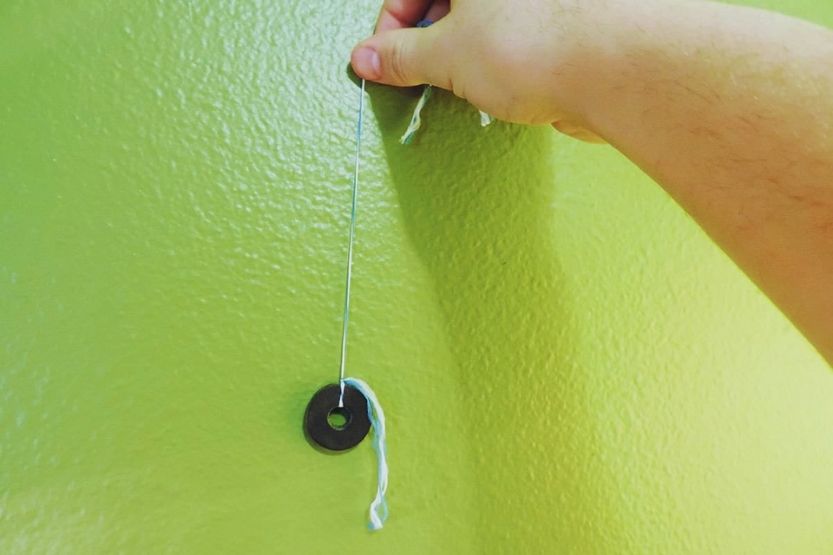If you are asked to hang artwork or shelves on a wall, you have to find the studs to avoid damaging the wall. But what if you don’t have a stud finder? Don’t worry; I’ll show you how to find a stud without a stud finder.
If you don’t have a stud finder, here are some of the things that you can do:
- Get a flashlight and then shine it against a wall at a steep angle.
- Inspect the walls and look for baseboards for nails.
- If you found a stud, use a tape measure to measure 16 inches from it to approximate the spot where the next stud is located.
- To be sure that it is a stud, drive a small nail into it.
There are many ways to find studs on a wall without using a stud finder. Experienced carpenters back when stud finders were not yet invented used different ways and means to do it. So can you if you read through this article.
Read on to learn more about the many ways you can find studs in a wall, even if you don’t have a stud finder.
How to Find a Stud Without Stud Finder

When you have to hang a picture frame on a wall, you have to nail its hook on a stud. If you drive the nail anywhere in the wall, you may damage the wall. The stud will give support to the frame as it hangs on the wall. But what if you don’t have a stud finder?
Here’s how to find studs without a stud finder:
- Load fresh batteries on your flashlight and shine its light against the wall you are putting the picture frame on. Point the light at a steep angle.
- Examine the wall and try to look for baseboards for nails.
- One you find a stud, get a tape measure. You will need it to measure about 16 inches from that stud to the next stud on the wall.
- Then drive a small nail into that spot to make sure that a stud is really there.
Use a Table Lamp Instead of Flashlight
Aside from a flashlight, you can also use anything that can emit good light intensity, such as a table lamp. When using a table lamp, remove its top or shade and hold the naked bulb about 10 to 12 inches away from the wall. Hopefully, you will see signs of the stud from there.
Most people nowadays assume that the only way to find studs on a wall is by using a stud finder. Well, if that’s true, then how did they find studs on walls when stud finders do not exist yet?
You Won’t Need a Stud Finder to Hang Artwork or Picture Frames
Another thing: to most people, they only need to find studs occasionally, to hang artwork or picture frames on their walls. So, if you’re not a full-time carpenter, you don’t need a stud finder to find studs where you can hang up a picture frame.
2×4 or 2×6 Studs
It is enough for you to know the common things about studs. For instance, you need to know that the studs used in most homes are the 2×4 or the 2×6. You can usually find them on the sides of doors and windows. Knowing such things will help you locate studs on drywalls even without using a stud finder.
How Walls Are Built

Before you start searching for studs on your wall, it is better to understand how walls are built. If you don’t have this information, you will be an easy pick for a salesperson who sells stud finders.
If you will use a stud finder to enable you to find studs so that you can hang a picture frame on your wall, your purchase of a stud finder is not justified. There are many other ways that you can do it. However, if your business requires the use of a stud finder every day, then, by all means, buy one.
Most Modern Homes Use the Stick-frame Design
While every house is unique, there are certain commonalities in its construction. For instance, house walls have a basic fundamental design and construction. Most modern homes use the stick-frame design.
Any house built from 1920 up is built this way. It would use 2×4 or 2×6 studs in constructing its frame. Studs will usually be located on the sides of doors and windows. Additionally, most light switches and electrical outlets will have a stud on their left or right side. If a home has trimmings, most likely, they are nailed to studs. You can use this information to find studs.
Other Things You Need to Know About Wall Construction
Here are other things you need to know about wall construction as they relate to studs:
- Studs are typically spaced from 16 inches to 24 inches from each other. The most common spacing is 16 inches.
- The usual location of a stud in a wall is either on the left side or the right side of a door or a window. However, the actual placement of a stud depends on the floor plan of the house. This means they can be spaced from each other more than the usual 16 inches.
- House trims, such as shoe moldings, baseboards, and crown molding, are typically nailed to studs.
- The actual dimensions of 2×4 and 2×6 studs are slightly smaller than their nominal dimensions. You also need to use this information in locating studs on drywalls.
How to Find a Stud in the Wall Without Stud Finder
The process of locating studs on drywall without using a stud finder is pretty simple. But you will need a set of tools that includes the following:
- Flashlight or a table lamp
- Tape measure
- Hammer and nail
- Wire hanger
Once you have these tools on hand, follow these steps:
1. Use a Flashlight
Turn on the flashlight and focus its light against the wall at a steep angle. Search for a column of dimples or bumps in the wall surface. The nails cause these surface dents that secure a wall section. There’s certainly a stud there.
2. Find Outlets or Nails
Look for outlets or nails on the baseboard. Baseboards are usually nailed to studs. Electrical outlets are also typically nailed to the sides of studs. On the middle part of the wall, electrical switches are typically located. They are also mounted on the stud as well.
3. Get Your Tape Measure
Once you’ve located a stud, get the tape measure and measure 16 inches away from it. The distance will show the location of the next stud. Then look for the same stud signs in the section of the wall.
4. Knock or Tap the Wall
You can also knock or tap on that area to see if it sounds solid or hollow. If the sound is solid, then that’s where the stud is. But if it is hollow, continue looking for the stud. It’s just nearby. If the stud is not in the next 16-inch, maybe it is 24 inches away.
If you believe that you have located the next stud, drive a small nail into it. The nail should hit wood under the drywall. If it does not, pull the nail out and insert a wire hanger into it. Then twist the hanger. If the stud is nearby, the wire of the hanger should hit it. That’s the location of the stud. You were just slightly off the first time.
Other Ways to Find Studs

There are other means by which you can find the exact locations of the studs on your wall. Once you have located a stud, follow what I have discussed earlier. Here are the other ways to find studs on drywall:
1. Use a Magnet
There’s another way on how to find wall studs without a stud finder. And this one is somewhat unorthodox:
- You will need a refrigerator magnet and a reasonable length of string or dental floss.
- Tie the magnet to the string.
- Then drag it across the wall. The nail’s head will attract the magnet.
- If the magnet sticks, you’ve found the location of the stud.
2. Use the Switch
You already know that one side of the switch or electrical outlet is mounted on a stud. It is either on the left or the right side. So, tap the sides of the switch or outlet to see if the stud is there. If it sounds hollow, it is not there. But if it sounds solid, the stud is there.
Now, measure around 3/4 inch away from the switch on the side where the stud is. Use that spot as your starting point in locating the next studs. They should be 16 inches apart (the most common stud spacing).
3. Use the Trim
You already know that carpenters mount house trims on studs. So, inspect the trim of the wall. Search for the exact spots where the nails were driven. There should be some dimples or holes on the trim. They could be painted over, so you need to search for them.
If you see just one single dimple, you have already located a stud. Now, keep on measuring 16 inches from there, and you will be able to locate the other studs on that wall.
4. Start Measuring from the Corner
You know that studs are generally spaced 16 inches apart. With that information, you can start from a corner and measure 16-inch intervals. But remember that not all rooms are the same. There are rooms where the studs are spaced more than 16 inches apart.
5. Knock or Tap Test
If this is the case in your room, you can use the knock or tap test. Start in a corner and check if you can gauge if the wall has shorter stud spacing. This is the best way to locate studs if you are searching for them outside of your house.
Now, if you have done all these, and still you haven’t found a single stud on the wall, then it’s time for you to use a stud finder. There’s no shame in doing this because you have already tried all the methods I’ve discussed above, and still, you’ve found nothing.
Electronic stud finders are available online. Choose one that will suit your need and one that is not too expensive but still reliable. Read the reviews first before buying one.
Conclusion: How to Find a Stud without Stud Finder
You don’t need to depend on a stud finder to find studs on a wall. There are several things you can do to find wall studs without using a stud finder. Some of the usual and easiest ways are the following:
- Get a flashlight and shine it against a wall at a steep angle.
- Inspect the walls and look for dimples of nails on the baseboards.
- If you found a stud and you’re sure that it is, then get a tape measure and measure 16 inches from it to approximate the spot where the next stud is located.
- Drive a small nail to be sure that what you have found is really a stud.
Related reading:
Is Duct Tape Conductive? Is Electrical Tape Conductive?
Smooth Silicone Caulk with Windex [How to]
How to Run Ethernet Cable Through Walls


![Read more about the article Whirlpool Fridge Not Cooling [9 Causes and Fixes]](https://homecarezen.com/wp-content/uploads/2020/09/whirlpool-fridge-not-cooling-enough-300x200.jpg)

